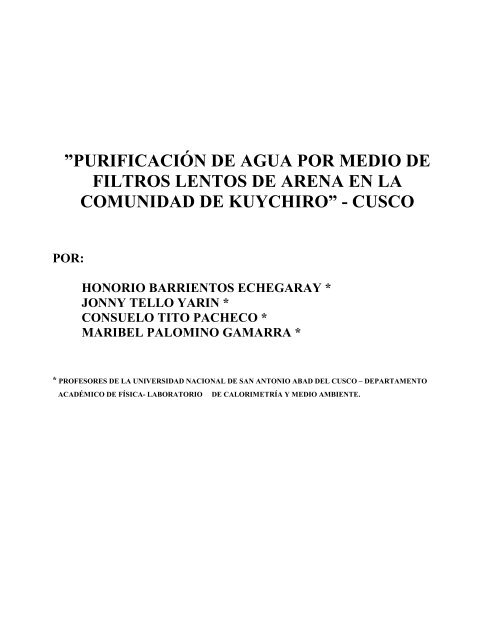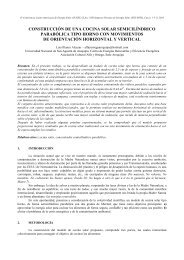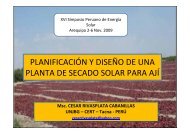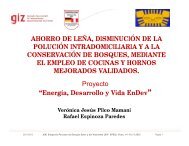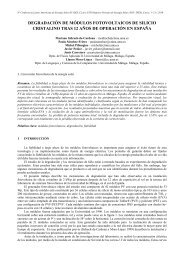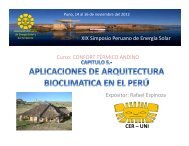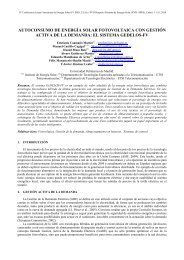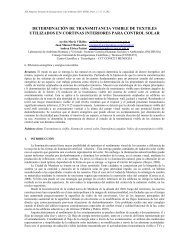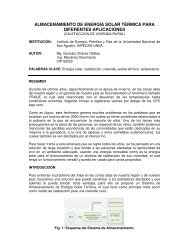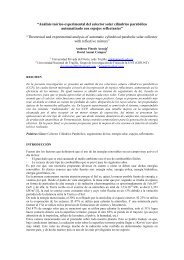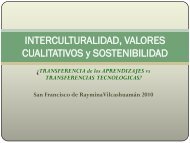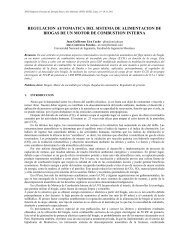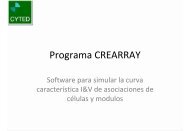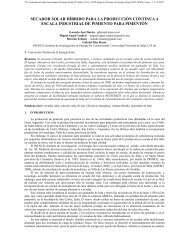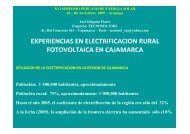Purificación de agua por medio de filtros lentos de arena en la ...
Purificación de agua por medio de filtros lentos de arena en la ...
Purificación de agua por medio de filtros lentos de arena en la ...
You also want an ePaper? Increase the reach of your titles
YUMPU automatically turns print PDFs into web optimized ePapers that Google loves.
”PURIFICACIÓN DE AGUA POR MEDIO DE<br />
FILTROS LENTOS DE ARENA EN LA<br />
COMUNIDAD DE KUYCHIRO” - CUSCO<br />
POR:<br />
HONORIO BARRIENTOS ECHEGARAY *<br />
JONNY TELLO YARIN *<br />
CONSUELO TITO PACHECO *<br />
MARIBEL PALOMINO GAMARRA *<br />
* PROFESORES DE LA UNIVERSIDAD NACIONAL DE SAN ANTONIO ABAD DEL CUSCO – DEPARTAMENTO<br />
ACADÉMICO DE FÍSICA- LABORATORIO<br />
DE CALORIMETRÍA Y MEDIO AMBIENTE.
ASPECTOS GENERALES<br />
Según INEI La comunidad <strong>de</strong> Kuychiro atraviesa <strong>por</strong> un alto <strong>de</strong>terioro <strong>en</strong> sus condiciones <strong>de</strong> vida<br />
<strong>en</strong>contrándose <strong>en</strong> una situación <strong>de</strong> abandono, pobreza y marginación, si<strong>en</strong>do uno <strong>de</strong> los sectores<br />
más vulnerables los niños, qui<strong>en</strong>es son afectados <strong>por</strong> los bajos niveles educativos, <strong>de</strong>snutrición y<br />
<strong>en</strong>fermeda<strong>de</strong>s (estomacales y cutáneas causadas <strong>por</strong> el <strong>agua</strong>).<br />
Los principales contaminantes <strong>de</strong> este río son:<br />
• El sistema <strong>de</strong> <strong>de</strong>sagüe <strong>de</strong> <strong>la</strong>s vivi<strong>en</strong>das que <strong>de</strong>sembocan <strong>en</strong> el mismo río <strong>en</strong> un 88% y el 12% <strong>de</strong><br />
<strong>la</strong> pob<strong>la</strong>ción que utiliza pozo negro o ciego.<br />
• Desperdicios orgánicos e inorgánicos que <strong>de</strong>secha <strong>la</strong> pob<strong>la</strong>ción <strong>en</strong> un 100%.<br />
T<strong>en</strong>i<strong>en</strong>do como consecu<strong>en</strong>cia <strong>la</strong> proliferación <strong>de</strong> coliformes fecales y totales <strong>en</strong> <strong>por</strong>c<strong>en</strong>tajes<br />
elevados.<br />
Es <strong>por</strong> esto que hace falta un estudio <strong>de</strong> los niveles <strong>de</strong> contaminación <strong>de</strong>l <strong>agua</strong> que consum<strong>en</strong> (río);<br />
e implem<strong>en</strong>tar un método que nos permita mejorar su calidad eliminando <strong>la</strong>s bacterias que son <strong>la</strong><br />
principal causa <strong>de</strong> <strong>la</strong>s <strong>en</strong>fermeda<strong>de</strong>s, <strong>por</strong> tal motivo nos hacemos <strong>la</strong> sigui<strong>en</strong>te pregunta. ¿La<br />
filtración l<strong>en</strong>ta <strong>de</strong> <strong>ar<strong>en</strong>a</strong> será un método efectivo para bajar los niveles <strong>de</strong> contaminación <strong>en</strong> el río y<br />
así obt<strong>en</strong>er <strong>agua</strong> apta para el consumo humano? El uso <strong>de</strong> <strong>la</strong> filtración <strong>en</strong> el tratami<strong>en</strong>to <strong>de</strong>l <strong>agua</strong> no<br />
es reci<strong>en</strong>te, conoci<strong>en</strong>do que <strong>la</strong> primera insta<strong>la</strong>ción <strong>de</strong> filtración <strong>en</strong> <strong>ar<strong>en</strong>a</strong> fue construida <strong>en</strong> el siglo<br />
XIX <strong>en</strong> Ing<strong>la</strong>terra, dichas insta<strong>la</strong>ciones filtraban <strong>agua</strong> sometida a los procesos <strong>de</strong> coagu<strong>la</strong>ción,<br />
flocu<strong>la</strong>ción y sedim<strong>en</strong>tación. Hasta 1950 muy poco se había avanzado <strong>en</strong> el proceso <strong>de</strong> filtración<br />
consi<strong>de</strong>rándose dos condiciones:<br />
• Que <strong>la</strong> carga hidráulica disponible se utilizará totalm<strong>en</strong>te.<br />
• Que <strong>la</strong> conc<strong>en</strong>tración <strong>de</strong> los sólidos <strong>en</strong> el <strong>agua</strong> filtrada alcanzará un valor pre<strong>de</strong>terminado<br />
La operación i<strong>de</strong>al era aquel<strong>la</strong> <strong>en</strong> que <strong>la</strong>s dos condiciones ocurrían simultáneam<strong>en</strong>te.<br />
Estos tipos <strong>de</strong> filtro también son usados <strong>en</strong> zonas rurales <strong>de</strong> diversas partes <strong>de</strong>l mundo.<br />
Específicam<strong>en</strong>te, <strong>en</strong> el distrito <strong>de</strong> Santiago se implem<strong>en</strong>to el programa <strong>de</strong> Saneami<strong>en</strong>to Básico y<br />
Nutrición t<strong>en</strong>i<strong>en</strong>do como sub programa <strong>la</strong> Construcción <strong>de</strong> Sistema <strong>de</strong> Abastecimi<strong>en</strong>to <strong>de</strong> Agua<br />
potable y <strong>de</strong>sagüe, si<strong>en</strong>do favorecido <strong>en</strong> el primer ítem un <strong>en</strong> 60% y <strong>en</strong> el segundo (insta<strong>la</strong>ción <strong>de</strong><br />
tuberías <strong>de</strong> <strong>de</strong>sagüe) <strong>en</strong> un 0% <strong>de</strong> <strong>la</strong> pob<strong>la</strong>ción, a<strong>de</strong>más <strong>de</strong>l sub programa <strong>de</strong> Infraestructura y<br />
Promoción <strong>de</strong> Servicios <strong>de</strong> Salud (Postas Sanitarias) <strong>la</strong>s cuales cu<strong>en</strong>tan con <strong>la</strong> infraestructura pero<br />
no con <strong>la</strong> implem<strong>en</strong>tación ni <strong>la</strong> at<strong>en</strong>ción.
OBJETIVOS GENERALES<br />
Purificar <strong>la</strong>s <strong>agua</strong>s <strong>de</strong>l río Kuychiro contaminado para consumo humano <strong>por</strong> El método <strong>de</strong><br />
filtración l<strong>en</strong>ta <strong>de</strong> <strong>ar<strong>en</strong>a</strong> y verificar que pueda utilizarse para consumo humano.<br />
OBJETIVOS ESPECÍFICOS<br />
• Evaluar el grado <strong>de</strong> contaminación <strong>de</strong>l <strong>agua</strong> mediante un análisis físico-químico y<br />
microbiológico <strong>de</strong> <strong>la</strong>s muestras obt<strong>en</strong>idas <strong>de</strong>l río Kuychiro.<br />
• Diseñar, construir el filtro l<strong>en</strong>to <strong>de</strong> <strong>ar<strong>en</strong>a</strong>.<br />
• Comparar el grado <strong>de</strong> contaminación antes y <strong>de</strong>spués <strong>de</strong> <strong>la</strong> filtración, comprobando <strong>la</strong> efici<strong>en</strong>cia<br />
<strong>de</strong> este método <strong>de</strong> Filtro L<strong>en</strong>to <strong>de</strong> Ar<strong>en</strong>a y purificando <strong>por</strong> <strong>medio</strong> <strong>de</strong> <strong>la</strong> cloración.<br />
• Promover este proyecto <strong>en</strong> <strong>la</strong> comunidad <strong>de</strong> Kuychiro y <strong>en</strong> lugares don<strong>de</strong> no cu<strong>en</strong>t<strong>en</strong> con el<br />
suministro <strong>de</strong> <strong>agua</strong> potable, y t<strong>en</strong>gan una fu<strong>en</strong>te <strong>de</strong> <strong>agua</strong> aprovechable para consumo humano<br />
(manante, río, etc.).<br />
JUSTIFICACIÓN<br />
El <strong>agua</strong> dulce es un recurso limitado. La pro<strong>por</strong>ción utilizable <strong>de</strong> este recurso es m<strong>en</strong>or al 1% <strong>de</strong>l<br />
total y 0.01% <strong>de</strong> todo el <strong>agua</strong> sobre <strong>la</strong> tierra (UNEP). Según <strong>la</strong> OMS, cada año muer<strong>en</strong> casi tres<br />
millones y <strong>medio</strong> <strong>de</strong> seres humanos, y <strong>en</strong> su mayoría niños con <strong>en</strong>fermeda<strong>de</strong>s diarreicas agudas<br />
(EDA) que son frecu<strong>en</strong>tem<strong>en</strong>te originadas <strong>por</strong> falta <strong>de</strong> servicios <strong>de</strong> <strong>agua</strong>. Los factores que agudizan<br />
el problema <strong>de</strong> <strong>de</strong>sabastecimi<strong>en</strong>to <strong>de</strong> <strong>agua</strong>s son: el crecimi<strong>en</strong>to imparable <strong>de</strong> <strong>la</strong> pob<strong>la</strong>ción y el efecto<br />
inverna<strong>de</strong>ro que acelera <strong>la</strong> <strong>de</strong>sertificación <strong>de</strong> muchas zonas alre<strong>de</strong>dor <strong>de</strong>l p<strong>la</strong>neta, afectando tanto el<br />
ciclo hídrico como al cambio climático y reduci<strong>en</strong>do <strong>la</strong> media <strong>de</strong> precipitaciones esperadas <strong>en</strong><br />
regiones ya <strong>de</strong>siertas o semi-<strong>de</strong>siertas. Por esta razón se establec<strong>en</strong> técnicas y estrategias que<br />
ayudarán el proceso <strong>de</strong> <strong>la</strong> purificación <strong>de</strong> <strong>agua</strong> para el consumo humano, una <strong>de</strong> estas técnicas es el<br />
uso <strong>de</strong> <strong>filtros</strong> <strong>l<strong>en</strong>tos</strong> <strong>de</strong> <strong>ar<strong>en</strong>a</strong> que son sistemas s<strong>en</strong>cillos y efectivos, don<strong>de</strong> el <strong>agua</strong> pasa a través <strong>de</strong><br />
lechos <strong>de</strong> capas <strong>de</strong> grava <strong>ar<strong>en</strong>a</strong> <strong>de</strong> difer<strong>en</strong>tes tamaños <strong>la</strong>s cuales reti<strong>en</strong><strong>en</strong> <strong>la</strong>s impurezas y patóg<strong>en</strong>os<br />
que conti<strong>en</strong><strong>en</strong>.<br />
CARACTERÍSTICAS DEL AGUA FÍSICOS Y QUÍMICOS<br />
• LA DENSIDAD. significa <strong>la</strong> masa <strong>de</strong> cierta cantidad <strong>de</strong> <strong>agua</strong>. (Kg/m 3 ).<br />
• CONDUCTIVIDAD. cantidad <strong>de</strong> electricidad el <strong>agua</strong> pue<strong>de</strong> conducir.<br />
• CARACTERÍSTICAS TERMALES. Se refiere a <strong>la</strong> temperatura <strong>de</strong> cambio <strong>de</strong> estado<br />
• VISCOSIDAD. Determina <strong>la</strong> movilidad <strong>de</strong>l <strong>agua</strong>. <strong>la</strong> viscosidad disminuye al aum<strong>en</strong>tar <strong>la</strong><br />
temperatura, es m<strong>en</strong>os móvil <strong>en</strong> temperaturas más altas.<br />
• ABSORCIÓN DE LUZ. Es <strong>la</strong> cantidad <strong>de</strong> luz que el <strong>agua</strong> absorber <strong>en</strong> un intervalo <strong>de</strong> tiempo.
• El pH. ti<strong>en</strong>e su propia esca<strong>la</strong>, funcionando para arriba a partir <strong>de</strong> 1 a 14. El pH<br />
<strong>de</strong>muestra si una sustancia es ácido (pH 1-6), neutro (pH 7) o básico (pH 8-14).<br />
• ALCALINIDAD. Es <strong>la</strong> capacidad <strong>de</strong>l <strong>agua</strong> <strong>de</strong> neutralizar un ácido o una base, <strong>de</strong> modo que el<br />
pH <strong>de</strong>l <strong>agua</strong> no cambie.<br />
CARACTERÍSTICAS TÉRMICAS DEL AGUA<br />
• El <strong>agua</strong> ti<strong>en</strong>e una <strong>de</strong> <strong>la</strong>s más altas capacida<strong>de</strong>s especificas, lo que <strong>la</strong> transforma <strong>en</strong> un sumi<strong>de</strong>ro<br />
<strong>de</strong> calor, consecu<strong>en</strong>tem<strong>en</strong>te, gran<strong>de</strong>s masas <strong>de</strong> <strong>agua</strong>s ti<strong>en</strong><strong>en</strong> un efecto regu<strong>la</strong>dor <strong>de</strong> <strong>la</strong> temperatura<br />
ambi<strong>en</strong>te.<br />
• El <strong>agua</strong> ti<strong>en</strong>e un calor <strong>la</strong>t<strong>en</strong>te <strong>de</strong> va<strong>por</strong>ización alto <strong>de</strong> 539 Cal/gr a 100ºC y 1 atm.<br />
• Calor requerido para pasar <strong>de</strong> sólido a liquido 80 cal/g, a 0 ºC y 1atm<br />
DIFERENTES CAPACIDADES ESPECÍFICAS DEL AGUA<br />
EN SUS TRES ESTADOS<br />
Estado Ce (cal/gr. o C) Ce (KJ/Kg o K) Ce(BTU/lb. o F)<br />
Liquido 1 4,18 1<br />
Sólido 0,5 2,09 0,5<br />
Va<strong>por</strong> (a 1 atm) 0,462 1,93 0,462<br />
CARACTERÍSTICAS BIOLÓGICAS DEL AGUA<br />
• Los microorganismos son especies vivi<strong>en</strong>tes <strong>de</strong> tamaños microscópicos<br />
• Se califica <strong>en</strong> un tercer reino l<strong>la</strong>mado Protista.<br />
• Tamaño pro<strong>medio</strong> <strong>de</strong> los Microorganismos<br />
– Tamaño : 10 – 6 m = 1µm<br />
– Peso < 10 -12 gr
CONTAMINACIÓN DEL AGUA<br />
CONTAMINANTES ORGÁNICOS MAS FRECUENTES<br />
FUENTE O ACTIVIDAD<br />
Desechos humanos<br />
Desechos alim<strong>en</strong>ticios<br />
Basura<br />
Misceláneos<br />
Agricultura<br />
Activida<strong>de</strong>s industriales<br />
Farmacéutica y petrolera<br />
Otras industriales<br />
- Procesadora <strong>de</strong> papel<br />
- Fa<strong>en</strong>adora <strong>de</strong> aves<br />
- Manufacturas <strong>de</strong><br />
alim<strong>en</strong>tos<br />
CONTAMINANTE ORGÁNICO<br />
Excrem<strong>en</strong>to, urea<br />
Azucares, almidones, alcoholes, grasas, Aceites, etc.<br />
Papel, cáscaras, hojas <strong>de</strong> té, Café molido<br />
Jabones, <strong>de</strong>terg<strong>en</strong>tes, shampoos<br />
Pesticidas<br />
Son los im<strong>por</strong>tantes y más variados<br />
Gama <strong>en</strong>orme <strong>de</strong> difer<strong>en</strong>tes<br />
Contaminantes, cada uno <strong>en</strong> una conc<strong>en</strong>tración pequeña<br />
Produc<strong>en</strong> g<strong>en</strong>eralm<strong>en</strong>te conc<strong>en</strong>traciones muy elevadas <strong>de</strong> un único tipo<br />
<strong>de</strong> contaminantes<br />
Celulosa<br />
Sangre<br />
Azucares<br />
ENFERMEDADES TRANSMITIDAS POR EL AGUA<br />
La pob<strong>la</strong>ción <strong>de</strong> escasos recursos económicos sufre frecu<strong>en</strong>tem<strong>en</strong>te <strong>en</strong>fermeda<strong>de</strong>s vincu<strong>la</strong>das a <strong>la</strong><br />
falta <strong>de</strong> <strong>agua</strong> limpia y <strong>de</strong> servicios <strong>de</strong> saneami<strong>en</strong>to, <strong>en</strong>tre el<strong>la</strong>s el EDA (<strong>en</strong>fermeda<strong>de</strong>s diarreicas<br />
agudas) y <strong>en</strong>fermeda<strong>de</strong>s cutáneas que juntas son responsables especialm<strong>en</strong>te <strong>de</strong> <strong>la</strong> mortandad <strong>en</strong><br />
niños y ancianos <strong>en</strong> un 26% a nivel mundial. El <strong>agua</strong> pue<strong>de</strong> transmitir <strong>en</strong>fermeda<strong>de</strong>s <strong>en</strong>téricas<br />
(intestinales), <strong>de</strong>bido al contacto con <strong>de</strong>sechos humanos o <strong>de</strong> animales, es <strong>la</strong> fu<strong>en</strong>te principal <strong>de</strong><br />
patóg<strong>en</strong>os <strong>en</strong>téricos: excrem<strong>en</strong>tos y otros <strong>de</strong>sechos eliminados <strong>por</strong> humanos <strong>en</strong>fermos y sus<br />
animales huéspe<strong>de</strong>s.<br />
Las <strong>en</strong>fermeda<strong>de</strong>s hídricas más im<strong>por</strong>tantes son producidas <strong>por</strong>:<br />
• Bacterias: Shigel<strong>la</strong>, Salmonel<strong>la</strong> y Escherichia, citrobacter, <strong>en</strong>terobacter, aerog<strong>en</strong>as, etc.<br />
• Virus: aquellos re<strong>la</strong>cionados con <strong>la</strong> Hepatitis y <strong>la</strong> Gastro<strong>en</strong>teritis
• Protozoos: Giardia Lambia, Entamoeba Histolytica.<br />
FILTRACIÓN<br />
La filtración es el proceso mediante el cual el <strong>agua</strong> es separada <strong>de</strong> <strong>la</strong> materia <strong>en</strong> susp<strong>en</strong>sión<br />
haciéndo<strong>la</strong> pasar a través <strong>de</strong> una sustancia <strong>por</strong>osa. En <strong>la</strong> práctica este material <strong>por</strong>oso es<br />
g<strong>en</strong>eralm<strong>en</strong>te <strong>ar<strong>en</strong>a</strong>.<br />
Hay dos tipos <strong>de</strong> <strong>filtros</strong> <strong>de</strong> <strong>ar<strong>en</strong>a</strong> los <strong>de</strong> acción l<strong>en</strong>ta y los <strong>de</strong> acción rápida.<br />
En los <strong>filtros</strong> <strong>l<strong>en</strong>tos</strong>, el <strong>agua</strong> pasa <strong>por</strong> gravedad a través <strong>de</strong> <strong>la</strong> <strong>ar<strong>en</strong>a</strong> a baja velocidad, <strong>la</strong> separación<br />
<strong>de</strong> los materiales sólidos se efectúa al pasar el <strong>agua</strong> <strong>por</strong> los <strong>por</strong>os <strong>de</strong> <strong>la</strong> capa filtrante y adherirse <strong>la</strong>s<br />
partícu<strong>la</strong>s a los granos <strong>de</strong> <strong>ar<strong>en</strong>a</strong>.<br />
Filtros rápidos <strong>de</strong> <strong>ar<strong>en</strong>a</strong>, El principal carácter distintivo estos <strong>filtros</strong>, consiste <strong>en</strong> <strong>la</strong> eliminación <strong>de</strong><br />
partícu<strong>la</strong>s <strong>en</strong> susp<strong>en</strong>sión, re<strong>la</strong>tivam<strong>en</strong>te gran<strong>de</strong>s <strong>por</strong> procesos físicos, durante esta operación estos<br />
sólidos son acumu<strong>la</strong>dos <strong>en</strong> <strong>la</strong> parte superior <strong>de</strong>l <strong>medio</strong> filtrante. Es mas, los <strong>filtros</strong> <strong>de</strong> <strong>ar<strong>en</strong>a</strong> <strong>de</strong><br />
acción rápida requier<strong>en</strong> limpiarse mediante una operación <strong>de</strong> reflujo un tanto complicado.<br />
MECANISMOS DE FILTRACIÓN<br />
La filtración es usualm<strong>en</strong>te consi<strong>de</strong>rada como el resultado <strong>de</strong> dos mecanismos distintos, pero<br />
complem<strong>en</strong>tarios: Trans<strong>por</strong>te y adher<strong>en</strong>cia.<br />
Los mecanismos que pue<strong>de</strong>n realizar trans<strong>por</strong>te son los sigui<strong>en</strong>tes:<br />
• Cernido<br />
• Sedim<strong>en</strong>tación<br />
• Intercepción<br />
• Difusión<br />
• Impacto inercial<br />
• Acción hidrodinámica<br />
Los mecanismos <strong>de</strong> adher<strong>en</strong>cia son los sigui<strong>en</strong>tes:<br />
• Interacción <strong>de</strong> <strong>la</strong>s Fuerzas Electrostáticas y <strong>de</strong> Van <strong>de</strong>r Waals<br />
• En<strong>la</strong>ce químico <strong>en</strong>tre <strong>la</strong>s partícu<strong>la</strong>s y <strong>la</strong> superficie <strong>de</strong> los granos<br />
FACTORES QUE INFLUYEN LA FILTRACIÓN<br />
• Tamaño <strong>de</strong> <strong>la</strong>s partícu<strong>la</strong>s susp<strong>en</strong>dida<br />
• D<strong>en</strong>sidad <strong>de</strong> <strong>la</strong>s partícu<strong>la</strong>s susp<strong>en</strong>didas<br />
• Resist<strong>en</strong>cia y dureza <strong>de</strong> los <strong>de</strong> <strong>la</strong>s particu<strong>la</strong>s susp<strong>en</strong>didas (floculos)<br />
• Temperatura <strong>de</strong>l <strong>agua</strong> a filtrar<br />
• Conc<strong>en</strong>tración <strong>de</strong> partícu<strong>la</strong>s susp<strong>en</strong>didas <strong>en</strong> el aflu<strong>en</strong>te<br />
• Pot<strong>en</strong>cial zeta <strong>de</strong> <strong>la</strong> susp<strong>en</strong>sión<br />
• pH <strong>de</strong>l aflu<strong>en</strong>te.<br />
CARACTERÍSTICAS DEL MEDIO FILTRANTE<br />
• TIPO DEL MEDIO FILTRANTE<br />
Un <strong>medio</strong> filtrante i<strong>de</strong>al es aquel <strong>de</strong> una <strong>de</strong>terminada granulometría y granos <strong>de</strong> un cierto peso<br />
específico que requiere una cantidad mínima <strong>de</strong> <strong>agua</strong> para ser <strong>la</strong>vado específicam<strong>en</strong>te y que es<br />
capaz <strong>de</strong> remover <strong>la</strong> mayor cantidad posible <strong>de</strong> partícu<strong>la</strong>s susp<strong>en</strong>didas, produci<strong>en</strong>do un<br />
eflu<strong>en</strong>te <strong>de</strong> bu<strong>en</strong>a calidad.<br />
• CARACTERÍSTICAS GRANULOMÉTRICAS DEL MATERIAL FILTRANTE<br />
- Tamaño efectivo<br />
- Coefici<strong>en</strong>te <strong>de</strong> uniformidad<br />
- Forma<br />
- Peso específico<br />
• EL ESPESOR DE LA CAPA FILTRANTE<br />
• CARACTERÍSTICAS HIDRÁULICAS<br />
- Tasa <strong>de</strong> filtración
- Calidad <strong>de</strong>l eflu<strong>en</strong>te<br />
- Carga hidráulica disponible<br />
- El método <strong>de</strong> control <strong>de</strong> los <strong>filtros</strong><br />
VENTAJAS DE LOS FILTROS LENTOS<br />
La filtración l<strong>en</strong>ta <strong>en</strong> <strong>ar<strong>en</strong>a</strong> ti<strong>en</strong>e muchas v<strong>en</strong>tajas<br />
• Mejora simultánea <strong>en</strong> <strong>la</strong> calidad física, química y bacteriológica <strong>de</strong>l <strong>agua</strong>, con un número <strong>de</strong><br />
v<strong>en</strong>tajas especiales para los países <strong>en</strong> <strong>de</strong>sarrollo tales como el nuestro.<br />
• La eficacia <strong>en</strong> <strong>la</strong> eliminación <strong>de</strong> bacterias totales es igual que <strong>en</strong> los <strong>filtros</strong> rápidos.<br />
• No se necesitan compuestos químicos.<br />
• La operación y mant<strong>en</strong>imi<strong>en</strong>to pue<strong>de</strong>n ser llevados a cabo <strong>por</strong> mano <strong>de</strong> obra semiespecializada.<br />
• El proceso <strong>de</strong> filtración es llevado a cabo <strong>por</strong> gravedad; no hay otras partes mecánicas que<br />
precis<strong>en</strong> <strong>de</strong> <strong>en</strong>ergía para funcionar.<br />
• El manejo <strong>de</strong> lodos no causa problemas; <strong>la</strong>s cantida<strong>de</strong>s <strong>de</strong> lodos son pequeñas ti<strong>en</strong>e muy alto<br />
cont<strong>en</strong>ido <strong>de</strong> materia seca.<br />
OPERACIÓN Y MANTENIMIENTO DE FILTRO LENTOS DE ARENA<br />
Todas <strong>la</strong>s activida<strong>de</strong>s <strong>de</strong> operación y mant<strong>en</strong>imi<strong>en</strong>to pue<strong>de</strong>n ser <strong>de</strong>sarrol<strong>la</strong>das <strong>por</strong> mano <strong>de</strong> obra<br />
local.<br />
TABLA DEL CENTRO INTERNACIONAL DE REFERENCIA PARA ABASTECIMIENTO<br />
PUBLICO DE AGUA DE LA OMS<br />
Parámetro<br />
Materia<br />
orgánica<br />
Bacteria<br />
Virus<br />
Color<br />
Turbiedad<br />
Efecto Purificador<br />
Los <strong>filtros</strong> <strong>l<strong>en</strong>tos</strong> <strong>de</strong> <strong>ar<strong>en</strong>a</strong> produc<strong>en</strong> un eflu<strong>en</strong>te c<strong>la</strong>ro, virtualm<strong>en</strong>te libre <strong>de</strong> materia<br />
orgánica.<br />
Pue<strong>de</strong> eliminarse <strong>en</strong>tre el 99% y 99.99% <strong>de</strong> bacterias patóg<strong>en</strong>as, <strong>la</strong>s cercarias <strong>de</strong><br />
esquistozoma, los quistes y huevos son eliminados aun con mayor grado. E. Coli<br />
reduce <strong>en</strong>tre 99% y 99.9%.<br />
En un filtro l<strong>en</strong>to ya maduro los virus se elimina <strong>en</strong> forma virtualm<strong>en</strong>te total<br />
El color se reduce <strong>en</strong> forma significativa.<br />
Pue<strong>de</strong> tolerarse <strong>en</strong> el <strong>agua</strong> cruda turbieda<strong>de</strong>s <strong>de</strong> 100 – 200 NTU solo <strong>por</strong> unos<br />
pocos días turbieda<strong>de</strong>s <strong>de</strong> más <strong>de</strong> 50 NTU son aceptables solo para unas pocas<br />
semanas: <strong>de</strong> prefer<strong>en</strong>cia, <strong>la</strong> turbiedad <strong>de</strong> <strong>agua</strong> <strong>de</strong>be ser m<strong>en</strong>or <strong>de</strong> 5 NTU, para un<br />
filtro l<strong>en</strong>to diseñado y operado con propiedad, <strong>la</strong> turbiedad <strong>de</strong>l eflu<strong>en</strong>te será m<strong>en</strong>or<br />
<strong>de</strong> 1 NTU.
TOMA DE DATOS, MATERIALES, DISEÑO Y CONSTRUCCIÓN DEL FILTRO LENTO<br />
DE ARENA<br />
INFORMACIÓN REFERENCIAL<br />
GENERALIDADES<br />
Kuychiro, cu<strong>en</strong>ta con una pob<strong>la</strong>ción <strong>de</strong> 428<br />
habitantes esta ubicada <strong>en</strong> el distrito <strong>de</strong><br />
Santiago. Es el lugar don<strong>de</strong> se efectuaron <strong>la</strong>s<br />
pruebas necesarias para esta investigación<br />
basada <strong>en</strong> <strong>la</strong> evaluación <strong>de</strong> <strong>la</strong> falta <strong>de</strong> <strong>agua</strong><br />
potable y <strong>de</strong> <strong>la</strong> situación económica <strong>en</strong> que se<br />
<strong>en</strong>cu<strong>en</strong>tra esta comunidad, ya que no cu<strong>en</strong>tan<br />
con los recursos necesarios para abastecer al<br />
100% sus necesida<strong>de</strong>s básicas.<br />
UBICACIÓN GEOGRÁFICA<br />
Latitud<br />
Longitud<br />
Altitud<br />
13 o 31’ 26” S<br />
71 o 58’ 47” O<br />
3663 msnm<br />
DISPOSICIÓN DEL SERVICIO DE AGUA<br />
• En esta comunidad <strong>la</strong> mayoría <strong>de</strong> los habitantes cu<strong>en</strong>tan con el servicio <strong>de</strong> <strong>agua</strong> potable<br />
(restringido) pero, una parte <strong>de</strong> ésta (especialm<strong>en</strong>te periferia) consum<strong>en</strong> <strong>agua</strong> <strong>de</strong>l río.<br />
• Los habitantes <strong>de</strong> este pob<strong>la</strong>do <strong>en</strong> un 100% utilizan <strong>la</strong>s <strong>agua</strong>s <strong>de</strong>l rió Kuychiro para <strong>la</strong> irrigación<br />
<strong>de</strong> sus p<strong>la</strong>ntaciones, alim<strong>en</strong>tación y aseo <strong>de</strong> sus animales, <strong>la</strong>vado <strong>de</strong> vegetales, que luego serán<br />
comercializados <strong>en</strong> el Cusco.<br />
El uso sin tratami<strong>en</strong>to <strong>de</strong> esta <strong>agua</strong> no es recom<strong>en</strong>dable para el consumo humano <strong>por</strong> el alto<br />
cont<strong>en</strong>ido <strong>de</strong> coliformes totales y termotolerantes que son causantes <strong>de</strong> muchas <strong>en</strong>fermeda<strong>de</strong>s <strong>en</strong><br />
esta zona.<br />
ENCUESTAS REALIZADAS<br />
A LA POBLACIÓN<br />
• Hay consumo <strong>de</strong> <strong>agua</strong> <strong>de</strong>l río.<br />
• El uso <strong>de</strong> esta <strong>agua</strong> para su consumo les produce <strong>en</strong>fermeda<strong>de</strong>s estomacales, cutáneas, etc.<br />
• Falta <strong>de</strong> interés <strong>de</strong> <strong>la</strong>s autorida<strong>de</strong>s compet<strong>en</strong>tes <strong>de</strong> abastecer <strong>agua</strong> <strong>en</strong> un 100%, brindarles servicio<br />
<strong>de</strong> limpieza pública y <strong>de</strong>sagüe.<br />
• Son consi<strong>en</strong>tes que contaminan <strong>la</strong>s <strong>agua</strong>s <strong>de</strong>l río Kuychiro arrojando sus <strong>de</strong>sperdicios orgánicos e<br />
inorgánicos.<br />
• Aceptación <strong>de</strong> nuevas formas <strong>de</strong> abastecer <strong>de</strong> <strong>agua</strong> potable para su consumo.<br />
• Aceptación <strong>de</strong> los pob<strong>la</strong>dores <strong>de</strong> capacitarse <strong>en</strong> esta nueva forma <strong>de</strong> abastecerse <strong>de</strong> este suministro<br />
básico.<br />
AL CENTRO DE SALUD<br />
• No cu<strong>en</strong>tan con un C<strong>en</strong>tro <strong>de</strong> Salud t<strong>en</strong>i<strong>en</strong>do una pob<strong>la</strong>ción <strong>de</strong> 107 familias.<br />
• Se ati<strong>en</strong><strong>de</strong>n <strong>en</strong> los C<strong>en</strong>tros <strong>de</strong> Salud más cercanos: Belempampa, Hospital Antonio Lor<strong>en</strong>a, posta<br />
<strong>de</strong> Zarzue<strong>la</strong>.<br />
• No cu<strong>en</strong>tan con ninguna información <strong>de</strong>l grado <strong>de</strong> contaminación <strong>de</strong>l río, ni <strong>la</strong> forma <strong>de</strong> prev<strong>en</strong>ir<br />
estos niveles <strong>de</strong> contaminación.<br />
• No llevan ningún control acerca <strong>de</strong> <strong>la</strong>s <strong>en</strong>fermeda<strong>de</strong>s estomacales (EDA), ni cutáneas.
• No cu<strong>en</strong>tan con ninguna información sobre <strong>la</strong> mortandad <strong>en</strong> este pob<strong>la</strong>do producido <strong>por</strong> el EDA u<br />
otras <strong>en</strong>fermeda<strong>de</strong>s.<br />
LA MUNICIPALIDAD DISTRITAL DE SANTIAGO.- No se cu<strong>en</strong>ta con servicio <strong>de</strong> limpieza<br />
pública y tampoco recib<strong>en</strong> ori<strong>en</strong>tación <strong>de</strong> cómo <strong>de</strong>sechar sus <strong>de</strong>sperdicios sin contaminar el <strong>medio</strong><br />
don<strong>de</strong> viv<strong>en</strong>.<br />
No se cu<strong>en</strong>ta con servicio <strong>de</strong> <strong>de</strong>sagüe <strong>en</strong> el pob<strong>la</strong>do.<br />
La Municipalidad no cu<strong>en</strong>ta con información sobre los niveles <strong>de</strong> contaminación <strong>de</strong> este río.<br />
No existe ninguna institución <strong>en</strong> el pob<strong>la</strong>do que se interese sobre los niveles <strong>de</strong> contaminación <strong>en</strong> <strong>la</strong><br />
que vive este pob<strong>la</strong>do.<br />
Luego <strong>de</strong> realizadas <strong>la</strong>s <strong>en</strong>cuestas y ver los resultados po<strong>de</strong>mos afirmar que es necesario<br />
implem<strong>en</strong>tar una forma <strong>de</strong> mejorar <strong>la</strong> calidad <strong>de</strong>l <strong>agua</strong> <strong>de</strong>l rio Kuychiro, y así po<strong>de</strong>r mejorar <strong>la</strong>s<br />
condiciones <strong>de</strong> vida <strong>de</strong> este pob<strong>la</strong>do es <strong>por</strong> esto que se implem<strong>en</strong>ta este proyecto.<br />
ESTUDIO DE LAS AGUAS DEL RIO KUYCHIRO<br />
Las <strong>agua</strong>s <strong>de</strong>l río se <strong>en</strong>cu<strong>en</strong>tran alteradas <strong>por</strong> <strong>la</strong> pres<strong>en</strong>cia <strong>de</strong> residuos sólidos y <strong>de</strong>smonte arrojado<br />
<strong>de</strong> forma irresponsable <strong>por</strong> los pob<strong>la</strong>dores <strong>de</strong> <strong>la</strong>s comunida<strong>de</strong>s sin previo tratami<strong>en</strong>to que aminore el<br />
impacto <strong>de</strong> contaminación y <strong>la</strong> zona agríco<strong>la</strong> que también contamina con fertilizantes químicos,<br />
p<strong>la</strong>guicidas, etc., los cuales son arrastrados <strong>por</strong> <strong>la</strong>s lluvias y <strong>agua</strong>s <strong>de</strong> regadío, que finalm<strong>en</strong>te llega<br />
al referido río, provocando un alto grado <strong>de</strong> contaminación <strong>de</strong> <strong>la</strong>s <strong>agua</strong>s y sus zonas <strong>de</strong> influ<strong>en</strong>cia,<br />
esta <strong>agua</strong> fueron sometidas a un análisis físico-químico y microbiológico cuyos resultados se<br />
pres<strong>en</strong>tan a continuación.<br />
Análisis Microbiológico<br />
Cuadro Nro. 01<br />
CARACTERÍSTICA<br />
NMP <strong>de</strong> coliformes<br />
Totales/100ml<br />
NMP <strong>de</strong> coliformes Termotolerantes<br />
(fecales)/100ml<br />
CANTIDAD<br />
1100<br />
460<br />
Análisis Físico-Químico<br />
Cuadro Nro. 02<br />
CARACTERÍSTICAS VALOR<br />
FÍSICO - QUÍMICAS<br />
Turbi<strong>de</strong>z NTU 1.80<br />
pH 7,72<br />
C.E. uS/cm 114,00<br />
Dureza ppm CaCO 3 74,10<br />
Calcio ppm 22,04<br />
Magnesio ppm 4,14<br />
Cloruros ppm 3,90<br />
Sulfatos ppm 16,10<br />
Bicarbonatos ppm 59,60<br />
Hierro ppm 0,055<br />
Sólidos disueltos ppm 122,50
Cuadro Nro. 03<br />
NIVELES DE CALIDAD DE AGUA PRODUCIDA POR SEDAQOSQO Y PARAMENTROS<br />
EXIGIDOS POR LA ORGANIZACIÓN MUNDIAL DE LA SALUD<br />
FÍSICOS<br />
PARÁMETROS<br />
UNIDAD<br />
Organización Mundial<br />
<strong>de</strong> <strong>la</strong> Salud (O. M. S)<br />
LIMITES<br />
SEDAQOSQO<br />
1 2 VALOR OBTENIDO<br />
Turbiedad U.T.N 5,00 2,50 0,70<br />
Temperatura<br />
O C 15,00<br />
Color U.C 5,00 50,00 5,00<br />
pH 7,0 -8,5 6,5-9,2 7,49<br />
Sólidos totales mg/l 500,00 1500,00 489,00<br />
QUÍMICOS<br />
Cloro residual pm 0,50 1,00 0,90<br />
Dureza total m/l 100,00 500,00 186,00<br />
Calcio m/l 0,00 200,00 68,00<br />
Cloruros m/l 200,00 250,00 13,00<br />
Hierro m/l 0,10 0,30 0,20<br />
Sulfato m/l 200,00 400,00 119,00<br />
Dióxido <strong>de</strong> Carbono m/l 4,80<br />
Magnesio m/l 0,00 200,00 3,40<br />
Alcalinidad Total CaCO 3 m/l 88,00<br />
Cuadro Nro. 04<br />
NIVELES DE CALIDAD DE AGUA PRODUCIDA POR SEDAQOSQO Y PARAMENTROS<br />
EXIGIDOS POR LA ORGANIZACIÓN MUNDIAL DE LA SALUD<br />
PARAMETROS UNIDAD LIMITES<br />
Organización Mundial <strong>de</strong> <strong>la</strong><br />
Salud (O. M. S)<br />
SEDAQOSQO<br />
1 2 VALOR OBTENIDO<br />
BACTERIOLOGICO<br />
Coliformes Totales 100 cc NMP 0 0 0<br />
Coliformes fecales 100 cc NMP 0 0 0
Al mismo tiempo se <strong>en</strong>contró un manante que <strong>de</strong>semboca al rio cuyos análisis pue<strong>de</strong><br />
verse a continuación<br />
Cuadro Nº 05<br />
CARACTERÍSTICA RIO MANANTE<br />
NMP <strong>de</strong> coliformes Totales/100ml 1100 460<br />
NMP <strong>de</strong> coliformes Termotolerantes (fecales)/100ml 460 150<br />
CARACTERÍSTICAS<br />
Análisis Físico-Químico<br />
Cuadro Nº 06<br />
Río Kuychiro<br />
(salida)<br />
Manante<br />
pH 6,86 7,11<br />
C.E. uS/cm 920,00 1286,00<br />
Dureza ppm CaCO3 594,00 848,80<br />
Calcio pmm 167,20 235,60<br />
Magnesio ppm 38,68 57,50<br />
Cloruros ppm 86,60 275,50<br />
Sulfatos ppm 394,20 370,10<br />
Bicarbonatos ppm 147,50 182,60<br />
Hierro ppm 0,145 0,160<br />
Sólidos disueltos ppm 960,00 1311,00<br />
PARTES DEL FILTRO LENTO DE ARENA<br />
DIFUSOR<br />
VÁLVULA FLOTADORA<br />
GEOTEXTIL<br />
TUBERÍA DE DRENAJE<br />
RECIPIENTE
TUBERÍAS DE ABASTECIMIENTO DE<br />
AGUA<br />
TANQUE DE ALMACENAMIENTO<br />
CONSTRUCCIÓN DEL FILTRO LENTO DE ARENA INSTALACIÓN DEL LECHO<br />
FILTRANTE<br />
GRAVA EN EL DENTRO DEL FILTRO<br />
ARENA GRUESA DENTRO<br />
DEL FILTRO<br />
ARENA FINA<br />
DENTRO DEL FILTRO<br />
CON AGUA CON AGUA CON AGUA
INSTALACIÓN DEL DIFUSOR Y GEOTEXTIL<br />
GEOTEXTIL Y DIFUSOR<br />
F. L. A. COMPLETO<br />
DIFUSOR Y GEOTEXTIL EN EL F. L. A,<br />
FILTRO LENTO DE ARENA<br />
PROPIEDADES FÍSICAS DE ALGUNOS MATERIALES UTILIZADOS<br />
– Ar<strong>en</strong>a, ti<strong>en</strong>e una <strong>de</strong>nsidad <strong>de</strong> 2,5 gr/cm 3 y <strong>la</strong> <strong>por</strong>osidad <strong>de</strong> este material es <strong>de</strong> 34,86%.<br />
– Grava, ti<strong>en</strong>e una <strong>de</strong>nsidad <strong>de</strong> 1,45 gr/cm 3 y <strong>la</strong> <strong>por</strong>osidad <strong>de</strong> este material es <strong>de</strong> 44%.<br />
– Ar<strong>en</strong>a gruesa, ti<strong>en</strong>e una <strong>de</strong>nsidad <strong>de</strong> 1,86 gr/cm 3 y <strong>la</strong> <strong>por</strong>osidad <strong>de</strong> este material es <strong>de</strong> 32,28%.<br />
FILTRO LENTO DE ARENA ARMADO<br />
FILTRO LENTO DE ARENA<br />
Ley<strong>en</strong>da<br />
1. Valvu<strong>la</strong> Flotadora.<br />
2. Geotextil<br />
3. Difusor<br />
4. Ar<strong>en</strong>a Fina<br />
5. Ar<strong>en</strong>a Gruesa<br />
6. Grava<br />
7. Tubería <strong>de</strong> dr<strong>en</strong>aje<br />
8. Tubería <strong>de</strong> abastecimi<strong>en</strong>to<br />
9. Tubo <strong>de</strong> oxig<strong>en</strong>ación<br />
10. Caño<br />
11. L<strong>la</strong>ve <strong>de</strong> paso<br />
12. Tapa<br />
13. Tubo <strong>de</strong> ingreso <strong>de</strong> <strong>agua</strong><br />
14. Sistema <strong>de</strong> almac<strong>en</strong>ami<strong>en</strong>to<br />
SISTEMA DE
GRAFICA Y ANÁLISIS DE DATOS DE LA ELIMINACIÓN DE LAS PARTÍCULAS<br />
EN FUNCIÓN DEL TIEMPO<br />
El cuadro po<strong>de</strong>mos observar el resum<strong>en</strong> <strong>de</strong> los resultados <strong>de</strong> los análisis microbiológicos<br />
Cuadro Nro. 07<br />
Característica<br />
Río<br />
Kuychiro<br />
Tratami<strong>en</strong>to<br />
Con F.L.A.<br />
(05 Días)<br />
Tratami<strong>en</strong>to<br />
Con F.L.A.<br />
(10 Días)<br />
Tratami<strong>en</strong>to<br />
Con F.L.A.<br />
(10 Días- Clorado)<br />
NMP <strong>de</strong> coniformes<br />
Totales/100ml<br />
1100 460 210 0<br />
NMP <strong>de</strong> coniformes<br />
termotolerantes(fecales)/100m<br />
460 240 150 0<br />
Los parámetros para realizar <strong>la</strong> grafica <strong>de</strong>l exam<strong>en</strong> microbiológico, efectuadas <strong>en</strong> <strong>la</strong>s <strong>agua</strong>s <strong>de</strong>l río<br />
Kuychiro, antes y <strong>de</strong>spués <strong>de</strong> <strong>la</strong> filtración con el F. L. A.<br />
Tiempo (Días)<br />
Cuadro Nro. 08<br />
Coliformes Totales<br />
0 1100<br />
5 460<br />
10 210<br />
Linealización <strong>de</strong> Grafico Coliformes<br />
Totales Vs Tiempo<br />
Coliformes totales Vs tiempo<br />
(gráfico linealizado)<br />
y = -89x + 1035<br />
R 2 = 0,9398<br />
Coliformes totales<br />
1200<br />
1000<br />
800<br />
600<br />
400<br />
200<br />
0<br />
0 2 4 6 8 10 12<br />
Tiempo
GRAFICA DE COLIFORMES TERMOTOLERANTES VS. EL TIEMPO<br />
Cuadro Nro 9<br />
COLIFORMES TERMOTOLERANTES<br />
VS. TIEMPO<br />
(GRAFICO LINEALIZADO)<br />
Días<br />
Coliformes Termotolerantes<br />
(Fecales)<br />
0 460<br />
5 240<br />
10 150<br />
Coliformes Termotolerantes vs. Tiempo
ANÁLISIS FÍSICO QUÍMICO<br />
Como po<strong>de</strong>mos ver <strong>en</strong> el cuadro <strong>la</strong>s cantida<strong>de</strong>s numéricas <strong>de</strong> los elem<strong>en</strong>tos exist<strong>en</strong>tes <strong>en</strong> el <strong>agua</strong><br />
antes <strong>en</strong> el proceso y <strong>de</strong>spués <strong>de</strong> <strong>la</strong> filtración, nos dan a <strong>en</strong>t<strong>en</strong><strong>de</strong>r que <strong>la</strong>s <strong>agua</strong>s <strong>de</strong>l rio Kuychiro son<br />
aptas para el consumo humano ya que estas cifras están <strong>por</strong> <strong>de</strong>bajo <strong>de</strong> <strong>la</strong>s cantida<strong>de</strong>s estándares<br />
permisibles <strong>por</strong> <strong>la</strong> Organización Mundial <strong>de</strong> <strong>la</strong> Salud.<br />
Cuadro Nro 10<br />
CARACTERÍSTICAS<br />
FÍSICO QUÍMICAS<br />
Río<br />
Kuychiro<br />
(1era<br />
muestra)<br />
2da<br />
Muestra<br />
(inicio <strong>de</strong>l<br />
proceso)<br />
Filtro L<strong>en</strong>to <strong>de</strong> Ar<strong>en</strong>a<br />
3era<br />
Muestra<br />
(5 días)<br />
4ta<br />
Muestra<br />
(10 días)<br />
5ta<br />
Muestra<br />
(Clorado)<br />
Turbi<strong>de</strong>z 1.80 1.50 1.48 1.36 0.92<br />
pH 7,72 7,90 6,90 7,02 7,25<br />
C.E. uS/cm 114,00 113,00 113,00 109,00 109,00<br />
Dureza ppmCaCO 3 74,10 72.60 74,20 71,90 71,90<br />
Calcio pmm 22,04 20,52 20,52 19,76 19,08<br />
Magnesio ppm 4,14 4,69 5,15 5,01 5,43<br />
Cloruros ppm 3,90 3,75 3,96 3,24 3,32<br />
Sulfatos ppm 16,10 17,5 16,72 14,90 14,00<br />
Bicarbonatos ppm 59,60 61,03 62,50 55,90 50,80<br />
Hierro ppm 0,055 0,064 0,062 0,070 0,056<br />
Sólidos disueltos ppm 122,50 124,20 120,80 116,60 114,70<br />
EFICIENCIA DEL FILTRO LENTO DE ARENA<br />
Para calcu<strong>la</strong>r <strong>la</strong> efici<strong>en</strong>cia <strong>de</strong>l Filtro L<strong>en</strong>to <strong>de</strong> Ar<strong>en</strong>a, tomaremos <strong>en</strong> cu<strong>en</strong>ta los datos <strong>de</strong>l exam<strong>en</strong><br />
físico químico el ítem <strong>de</strong> TURBIDEZ y <strong>de</strong>l análisis microbiológico antes y <strong>de</strong>spues <strong>de</strong> <strong>la</strong> filtración.<br />
Calculo <strong>de</strong> efici<strong>en</strong>cia <strong>de</strong>l filtro <strong>en</strong> <strong>la</strong> remoción <strong>de</strong> sólidos poco sedim<strong>en</strong>tables (turbi<strong>de</strong>z)<br />
Efici<strong>en</strong>cia <strong>de</strong>l filtro con = Turbi<strong>de</strong>z <strong>de</strong>l río Kuychiro – Turbi<strong>de</strong>z <strong>de</strong>spués <strong>de</strong>l filtrado<br />
respecto a <strong>la</strong> turbi<strong>de</strong>z con el F. L. A<br />
La efici<strong>en</strong>cia <strong>de</strong> filtrado <strong>de</strong> <strong>la</strong> turbiedad, como po<strong>de</strong>mos apreciar es <strong>de</strong> 24,44%.<br />
n<br />
turb<br />
n<br />
turb<br />
= 1,80 −1,36<br />
= 0,44<br />
Calcu<strong>la</strong>mos<br />
1,80 →100%<br />
0,44 → n<br />
turb<br />
n<br />
turb<br />
0,44x100%<br />
=<br />
1,88
Calculo <strong>de</strong> <strong>la</strong> efici<strong>en</strong>cia <strong>de</strong>l Filtro con los datos obt<strong>en</strong>idos <strong>de</strong>l análisis microbiológico tomando <strong>en</strong><br />
cu<strong>en</strong>ta los COLIFORMES TOTALES<br />
Efici<strong>en</strong>cia <strong>de</strong> filtrado <strong>de</strong> = Coliformes Totales <strong>de</strong>l - Coliformes Totales con F. L. A.<br />
Coliformes Totales río Kuychiro<br />
1100 CT<br />
→ 100 %<br />
890 CT<br />
→ η %<br />
η CT<br />
=1100 − 210<br />
η<br />
CT<br />
890 CT × 100 %<br />
=<br />
1100 CT<br />
η CT<br />
= 890<br />
η<br />
CT<br />
= 80,91 %<br />
La efici<strong>en</strong>cia <strong>de</strong> filtrado <strong>de</strong> los Coliformes Totales, como po<strong>de</strong>mos apreciar es <strong>de</strong> 80,91%.<br />
ANÁLISIS MICROBIOLÓGICO<br />
Cuadro Nro. 11<br />
Características Río<br />
Kuychiro<br />
Tratami<strong>en</strong>to<br />
Con F. L. A.<br />
NMP <strong>de</strong> coniformes<br />
Totales/100ml<br />
(10 Días)<br />
1100 210<br />
Calculo <strong>de</strong> <strong>la</strong> efici<strong>en</strong>cia <strong>de</strong>l Filtro con los datos obt<strong>en</strong>idos <strong>de</strong>l análisis microbiológico tomando <strong>en</strong><br />
cu<strong>en</strong>ta los COLIFORMES TERMOTOLERANTES (fecales).<br />
Efici<strong>en</strong>cia <strong>de</strong> filtrado <strong>de</strong> = Coliformes Fecales – Coliformes Fecales con F. L. A.<br />
Coliformes Termotolerantes <strong>de</strong>l río Kuychiro<br />
460<br />
C . Fecales<br />
→<br />
100<br />
%<br />
310<br />
C . Fecales<br />
→ η %<br />
η CF<br />
= 460 −150<br />
=<br />
310<br />
η<br />
CF<br />
%<br />
=<br />
310<br />
Fecales × 100<br />
460 Fecales<br />
%<br />
η<br />
CF<br />
%<br />
=<br />
67<br />
.39<br />
%<br />
Como po<strong>de</strong>mos apreciar que <strong>la</strong> efici<strong>en</strong>cia <strong>de</strong>l filtro <strong>en</strong> remover los Coliformes fecales <strong>de</strong> <strong>la</strong>s <strong>agua</strong>s<br />
<strong>de</strong>l río Kuychiro es: 67,39%<br />
EXAMEN MICROBIOLÓGICO<br />
Cuadro Nro. 12<br />
Característica<br />
Río<br />
Kuychiro<br />
NMP <strong>de</strong> coniformes<br />
termotolerantes(fecales)/100ml<br />
Tratami<strong>en</strong>to<br />
Con F.L.A.<br />
(10 Días)<br />
460 150
RESUMEN COMPARATIVO DE LOS ANÁLISIS MICROBIOLÓGICO Y FÍSICO QUÍMICO DE<br />
LAS MUESTRAS DE AGUA DEL RIO KUYCHIRO.<br />
En el sigui<strong>en</strong>te cuadro se muestra los análisis (Físico Químico) <strong>de</strong> cada proceso <strong>de</strong> filtración.<br />
CARACTERÍSTICAS<br />
FÍSICO QUÍMICAS<br />
Río<br />
Kuychiro<br />
1era<br />
Muestra<br />
Cuadro Nro. 13<br />
2da<br />
Muestra<br />
(inicio <strong>de</strong>l<br />
proceso)<br />
Filtro L<strong>en</strong>to <strong>de</strong> Ar<strong>en</strong>a<br />
3da<br />
Muestra<br />
(5 días)<br />
4ta<br />
Muestra<br />
(10 días)<br />
5ta<br />
Muestra<br />
(Clorado)<br />
Efici<strong>en</strong>cia <strong>de</strong>l<br />
F. A. L. (%)<br />
Río Kuychiro<br />
sin tratar<br />
y 4ta muestra<br />
tratada<br />
Turbi<strong>de</strong>z 1.80 1.50 1.48 1.36 0.92 24,6<br />
pH 7,72 7,90 6,90 7,02 7,25 9,1<br />
C.E. uS/cm 114,00 113,00 113,00 109,00 109,00 4,4<br />
Dureza ppmCaCO<br />
3<br />
74,10 72.60 74,20 71,90 71,90 3<br />
Calcio pmm 22,04 20,52 20,52 19,76 19,08 10,3<br />
Cloruros ppm 3,90 3,75 3,96 3,24 3,32 16,9<br />
Sulfatos ppm 16,10 17,5 16,72 14,90 14,00 13<br />
Bicarbonatos ppm 59,60 61,03 62,50 55,90 50,80 13,9<br />
Sólidos disueltos ppm 122,50 124,20 120,80 116,60 114,70 4,81<br />
Característica<br />
NMP <strong>de</strong><br />
coniformes<br />
Totales/100ml<br />
NMP <strong>de</strong><br />
coniformes<br />
Termotolerantes<br />
(fecales) /100ml<br />
Río<br />
Kuychiro<br />
Tratami<strong>en</strong>to<br />
Con F.L.A.<br />
(05 Días)<br />
Tratami<strong>en</strong>to<br />
Con F.L.A.<br />
(10 Días)<br />
Tratami<strong>en</strong>to<br />
Con F.L.A.<br />
(10 Días-<br />
Clorado)<br />
Efici<strong>en</strong>cia <strong>de</strong>l F.<br />
A. L. (%) Río<br />
Kuychiro sin<br />
tratar<br />
y a los 10 días <strong>de</strong>l<br />
filtrado<br />
1100 460 210 0 80,91<br />
460 240 150 0 67,39
CUADRO COMPARATIVO DE LA Nº 13 Y 3<br />
CARACTERÍSTICAS<br />
FÍSICO QUÍMICAS<br />
Río<br />
Kuychiro<br />
1era<br />
Muestra<br />
2da<br />
Muestra<br />
(inicio <strong>de</strong>l<br />
proceso)<br />
Filtro L<strong>en</strong>to <strong>de</strong> Ar<strong>en</strong>a Efici<strong>en</strong>cia <strong>de</strong>l F.<br />
A. L. (%)<br />
3da<br />
Muestra<br />
(5 días)<br />
4ta<br />
Muestra<br />
(10 días)<br />
5ta<br />
Muestra<br />
(Clorado)<br />
Río Kuychiro<br />
sin tratar<br />
y 4ta muestra<br />
tratada<br />
Turbi<strong>de</strong>z 1.80 1.50 1.48 1.36 0.92 24,6<br />
pH 7,72 7,90 6,90 7,02 7,25 9,1<br />
C.E. uS/cm 114,00 113,00 113,00 109,00 109,00 4,4<br />
Dureza ppmCaCO<br />
3<br />
74,10 72.60 74,20 71,90 71,90 3<br />
Calcio pmm 22,04 20,52 20,52 19,76 19,08 10,3<br />
Cloruros ppm 3,90 3,75 3,96 3,24 3,32 16,9<br />
Sulfatos ppm 16,10 17,5 16,72 14,90 14,00 13<br />
Bicarbonatos ppm 59,60 61,03 62,50 55,90 50,80 13,9<br />
Sólidos disueltos ppm 122,50 124,20 120,80 116,60 114,70 4,81<br />
PARÁMETROS<br />
UNIDAD<br />
Organización Mundial <strong>de</strong> <strong>la</strong><br />
Salud (O. M. S)<br />
LIMITES<br />
SEDAQOSQO<br />
1 2 VALOR OBTENIDO<br />
FÍSICOS<br />
Turbiedad U.T.N 5,00 2,50 0,70<br />
Temperatura<br />
O C 15,00<br />
Color U.C 5,00 50,00 5,00<br />
pH 7,0 -8,5 6,5-9,2 7,49<br />
Sólidos totales mg/l 500,00 1500,00 489,00<br />
QUÍMICOS<br />
Cloro residual pm 0,50 1,00 0,90<br />
Dureza total m/l 100,00 500,00 186,00<br />
Calcio m/l 0,00 200,00 68,00<br />
Cloruros m/l 200,00 250,00 13,00<br />
Hierro m/l 0,10 0,30 0,20<br />
Sulfato m/l 200,00 400,00 119,00<br />
Dióxido <strong>de</strong> Carbono m/l 4,80<br />
Magnesio m/l 0,00 200,00 3,40<br />
Alcalinidad Total CaCO 3 m/l 88,00
CONCLUSIONES<br />
1. En el análisis físico químico <strong>de</strong> <strong>la</strong>s muestras <strong>de</strong> <strong>agua</strong>, se comprueba que estas cumpl<strong>en</strong> con <strong>la</strong>s<br />
especificaciones técnicas para el consumo humano, consi<strong>de</strong>rando como aspecto principal <strong>la</strong> DUREZA <strong>de</strong><br />
<strong>la</strong> sustancia ya que <strong>de</strong>bía estar bajo los niveles <strong>de</strong> aceptación establecidos <strong>por</strong> <strong>la</strong> OMS (Organización<br />
Mundial <strong>de</strong> <strong>la</strong> Salud).<br />
2. La utilización <strong>de</strong> <strong>filtros</strong> <strong>l<strong>en</strong>tos</strong> <strong>de</strong> <strong>ar<strong>en</strong>a</strong> <strong>en</strong> <strong>la</strong> purificación <strong>de</strong>l <strong>agua</strong> para su consumo es factible, puesto<br />
que se ha comprobado mediante los análisis realizados (microbiológico) que los niveles <strong>de</strong> contaminación<br />
bajaron <strong>en</strong> un <strong>por</strong>c<strong>en</strong>taje consi<strong>de</strong>rable <strong>de</strong> 80,91% <strong>en</strong> remoción <strong>de</strong> Coliformes Totales y <strong>en</strong> un 67,39% <strong>en</strong><br />
Coliformes Termotolerantes.<br />
3. El modulo <strong>de</strong>l FILTRO LENTO DE ARENA ha permitido obt<strong>en</strong>er <strong>la</strong> cantidad <strong>de</strong> <strong>agua</strong> <strong>de</strong>scontaminada<br />
<strong>de</strong> 282, 53 litros durante 12 horas, contando con una caudal <strong>de</strong>l aflu<strong>en</strong>te 1,2 l/s.<br />
4. Los resultados obt<strong>en</strong>idos satisfac<strong>en</strong> al problema p<strong>la</strong>nteado mas corroborando con <strong>la</strong> <strong>en</strong>cuesta realizada <strong>en</strong><br />
<strong>la</strong> Comunidad <strong>de</strong> Kuychiro.<br />
5. Este proyecto <strong>de</strong> investigación permitió el <strong>de</strong>sarrollo y avance <strong>de</strong> <strong>la</strong> ci<strong>en</strong>cia <strong>en</strong> el campo <strong>de</strong> <strong>la</strong> tecnología,<br />
asimismo nos permitió cumplir <strong>la</strong>s expectativas esperadas.


